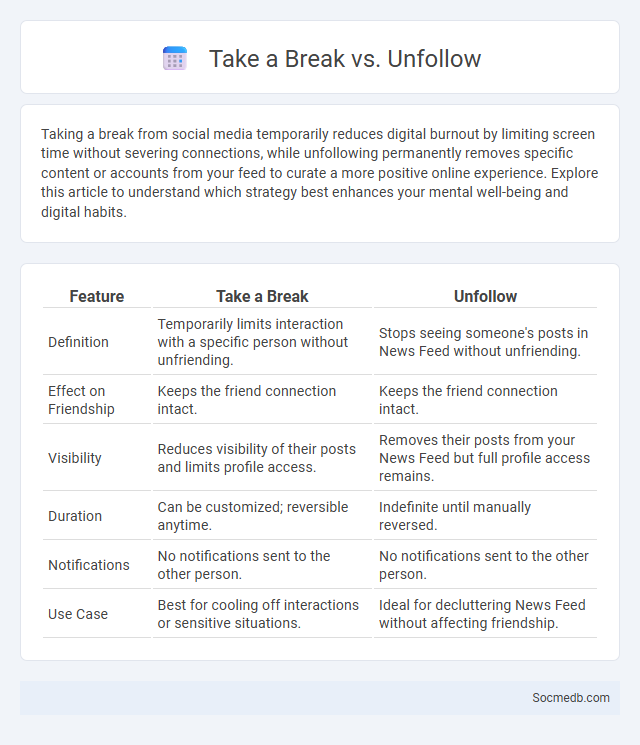
Photo illustration: Take a Break vs Unfollow
Taking a break from social media temporarily reduces digital burnout by limiting screen time without severing connections, while unfollowing permanently removes specific content or accounts from your feed to curate a more positive online experience. Explore this article to understand which strategy best enhances your mental well-being and digital habits.
Table of Comparison
| Feature | Take a Break | Unfollow |
|---|---|---|
| Definition | Temporarily limits interaction with a specific person without unfriending. | Stops seeing someone's posts in News Feed without unfriending. |
| Effect on Friendship | Keeps the friend connection intact. | Keeps the friend connection intact. |
| Visibility | Reduces visibility of their posts and limits profile access. | Removes their posts from your News Feed but full profile access remains. |
| Duration | Can be customized; reversible anytime. | Indefinite until manually reversed. |
| Notifications | No notifications sent to the other person. | No notifications sent to the other person. |
| Use Case | Best for cooling off interactions or sensitive situations. | Ideal for decluttering News Feed without affecting friendship. |
Understanding Take a Break, Unfollow, and Unfriending
Understanding the impact of social media on your mental health requires recognizing tools like Take a Break, Unfollow, and Unfriending as essential for digital well-being. Take a Break allows temporary pauses from seeing someone's content to reduce stress, while Unfollow helps customize your feed by stopping posts without severing connections. Unfriending removes connections entirely, offering a way to maintain control over your online environment and protect your emotional space.
What Happens When You Take a Break?
Taking a break from social media often leads to reduced stress levels and improved mental clarity by lowering exposure to constant notifications and comparison triggers. Users commonly experience enhanced real-life relationships and increased productivity due to regained focus and presence in daily activities. Extended disconnection also promotes better sleep patterns and greater mindfulness, contributing to overall emotional well-being.
Effects of Unfollowing: Staying Connected Silently
Unfollowing on social media reduces algorithmic clutter while maintaining passive awareness of others' updates, fostering a balance between engagement and personal space. This silent connection allows users to manage emotional well-being by limiting exposure to potentially stressful content without severing social ties. Research shows that strategic unfollowing can enhance mental health and improve online experience without diminishing social capital.
Unfriending: Cutting the Cord Completely
Unfriending on social media involves permanently removing someone from your friends list, severing all digital connections and interactions. This action not only blocks content sharing but also restricts private messaging and visibility of posts. Choosing to unfriend is a definitive step to maintain online boundaries and control personal information exposure.
Pros and Cons of Each Option
Social media platforms like Facebook, Instagram, Twitter, LinkedIn, and TikTok each present unique advantages and disadvantages. Facebook excels in connecting diverse age groups and supports extensive community building but often struggles with misinformation and privacy concerns. Instagram offers high visual engagement and brand visibility yet may contribute to unrealistic self-image and mental health issues. Twitter provides real-time news and public discourse but is prone to misinformation and harassment. LinkedIn focuses on professional networking and job opportunities but can be perceived as overly formal and less personal. TikTok drives viral content and creativity among younger audiences but raises concerns about data privacy and addictive usage patterns.
Privacy Implications: What Others Can See
Social media platforms often allow users to share personal information, photos, and location data that can be publicly accessible depending on privacy settings. Friends, followers, or even strangers may view posts, comments, and activity logs, increasing the risk of identity theft or unwanted attention. Users should regularly review privacy controls to limit visibility and protect sensitive data from being exposed online.
Emotional Impact: Choosing the Healthiest Approach
Your emotional well-being is significantly affected by how you engage with social media platforms. Selecting a balanced approach that limits exposure to negative content and promotes positive interactions can reduce stress, anxiety, and feelings of inadequacy. Prioritizing mindful usage habits strengthens emotional resilience and helps maintain a healthier mental state in the digital age.
When to Take a Break vs When to Unfriend
Recognizing when to take a break from social media versus unfriending someone hinges on the impact of their content on your well-being. If posts occasionally cause minor stress or distraction, a temporary break can help restore your mental clarity without permanent consequences. However, if certain connections consistently spread negativity or harm your online experience, unfriending is a proactive step to protect Your digital environment from toxic influences.
Managing Digital Boundaries Mindfully
Managing digital boundaries mindfully involves setting clear limits on social media usage to protect your mental health and personal time. Prioritizing intentional interactions over passive scrolling helps reduce stress and prevent digital burnout. Establishing specific hours for social media engagement ensures a balanced online presence while fostering meaningful real-life connections.
Making the Right Choice for Your Mental Wellbeing
Choosing the right social media platforms and setting clear boundaries can significantly improve your mental wellbeing by reducing exposure to harmful content and minimizing digital overload. Prioritizing accounts that promote positivity, education, and support can foster a healthier online environment. Establishing regular screen time limits and engaging in offline activities can help maintain a balanced lifestyle conducive to emotional resilience.
 socmedb.com
socmedb.com